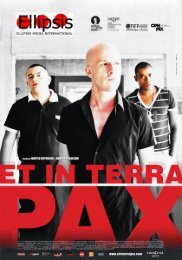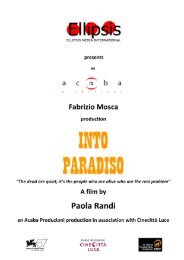Luciano Lischi, editore, un film di Daniele Segre - Ellipsis
Luciano Lischi, editore, un film di Daniele Segre - Ellipsis
Luciano Lischi, editore, un film di Daniele Segre - Ellipsis
- No tags were found...
Create successful ePaper yourself
Turn your PDF publications into a flip-book with our unique Google optimized e-Paper software.
LISETTA CARMI, A SOUL ON THE ROADItaly, 2010, HDV, 54'Movie subject, e<strong>di</strong>ting, <strong>di</strong>recting: <strong>Daniele</strong> <strong>Segre</strong>Cinematography: Franco RobustMusic: Maria Teresa SoldaniDirect so<strong>un</strong>d: Edgar IacolennaAssistant <strong>di</strong>rector and e<strong>di</strong>tor: Maria Teresa SoldaniProduction: I Cammelli S.a.s.Distribution: I Cammelli S.a.s.<strong>Daniele</strong> <strong>Segre</strong> and photographer Lisetta Carmi first met in Ravenna in January 2009 for a monographicexhibition on the photographer, who is originally from Genova. Some months later Lisetta wrote a letter to<strong>Daniele</strong> and invited him to Cisternino, in Puglia, where she has been living for the last forty years. Shewanted to tell him the story of her life. On that occasion, Lisetta took out of her archives all her photos, toldthe <strong>film</strong> <strong>di</strong>rector about them and, after many years, she played the piano again, her first great passion.Lisetta had an incre<strong>di</strong>ble life. She was born on February 15, 1924in Via Sturla 15 in Genova in a middle-class Jewish family. Shestarted studying music when she was very yo<strong>un</strong>g and she becamea promising piano player. Later, she quit playing the piano and shedevoted herself to photography, the other great passion of her life.As in a great novel of the XX century, stories and painful andextraor<strong>di</strong>nary events took place amidst new choices and a newcon<strong>di</strong>tion of awareness. Memories of a world <strong>di</strong>sappeared after thewar, of the racial laws and of when she fled to Switzerland bringingwith her Bach’s “Well-tempered Clavier” sheet music. Then hermemories of Genova in the 1960’s: the intellectuals and the artistswith whom she started her career as a photographer, thetransvestites, the harbour workers, eroticism and authoritarianism in the monumental cemetery in Staglieno,her travels to document the world, the striking photographic enco<strong>un</strong>ter with Ezra Po<strong>un</strong>d. Finally, her deepmystical enco<strong>un</strong>ter with Babaji and the buil<strong>di</strong>ng of the Ashram in Cisternino, the first Ashram of this kind builtin the Western world, for which she abandoned photography for good. The backgro<strong>un</strong>d and the subjects ofher life’s events are Genova, Israel, Sicily, Sar<strong>di</strong>nia, Paris, Venezuela, Mexico, England, Ireland, Greece,Afghanistan, In<strong>di</strong>a and the region ofPuglia. Lisetta Carmi is one of the mostimportant photographers in Italian an<strong>di</strong>nternational history.Her photos, her vision of the world andher passionate work, her alternativeapproach to mainstream trends in thesociety of the 1960’s and the 1970’shave left a mark in the world of art thatis still visible today. Her pictures of EzraPo<strong>un</strong>d were awarded the Niépce Prizeand, as many others of her pictures,they were published and exhibited allover the world. Lisetta Carmi is “a soulon the road” in the endless search for truth in people’s life and in the world aro<strong>un</strong>d her..« It has been very important for me to meet Lisetta Carmi. I <strong>di</strong>d not know her personally; I liked her workvery much, especially the photos of transvestites and of Ezra Po<strong>un</strong>d. I met her on the 17th of January 2009in Ravenna, in occasion of the opening of an exhibition on her work. That’s when I first felt the desire tomake a documentary about her. After many months, Lisetta wrote me a letter. She had listened to aninterview I had given on the ra<strong>di</strong>o and she invited me to Cisternino. So I went.I needed to take this journey. Not only was it necessary to portray a great photographer’s work, but also todepict the compassion of a person who has chosen to consecrate her many lives to others, bravelycommitting to this task. » <strong>Daniele</strong> <strong>Segre</strong>© I Cammelli S.a.s. – www.danielesegre.itVia Cantalupo 11, 10141 – TorinoP.IVA 03871000018Tel. (+39) 011/56 95 620 Fax. (+39) 011/56 95 619icammelli.torino@gmail.com
BIOFILMOGRAPHY - <strong>Daniele</strong> <strong>Segre</strong><strong>di</strong>rector - professor - producerwww.danielesegre.iticammelli.torino@gmail.comphone (+39) 0115695620fax (+39) 0115695619cell (+39) 3402252624Sta<strong>di</strong>um) (Mazzotta, Milan).<strong>Daniele</strong> <strong>Segre</strong> (Alessandria, Italy 1952)is a <strong>di</strong>rector of « cinema of reality », offiction <strong>film</strong>s and of theatre plays.He started in Turin as a realityphotographer. Since the middle 1970’she has been making <strong>film</strong>s and videos.Perché Droga (Why Drugs) 1976, Ilpotere dev’essere bianconero (Power toJuventus football team), 1978 arefocused on the real problems of needyyouth. Vite <strong>di</strong> ballatoio (Life on thebalcony), 1984, shows the <strong>di</strong>gnity andhumanity of lives of great hardships. In1980 he published the photographicbook Ragazzi <strong>di</strong> sta<strong>di</strong>o (Youth from theIn 1981 <strong>Segre</strong> fo<strong>un</strong>ded « I Cammelli » <strong>film</strong> production company and in 1983 he wrote and <strong>di</strong>rectedhis first feature-length <strong>film</strong>, Testadura (Stubborn), which was presented at the Venice Film Festivalthat year. This fiction is about the small world of a yo<strong>un</strong>g man, a micro-reality made up of stubbornchoices, of a tiring daily life and of <strong>di</strong>fficult relationships. In his second feature-length <strong>film</strong>,Manila Paloma Blanca, 1992, <strong>Segre</strong> looked into the existence of an outcast actor, interpreted byCarlo Colnaghi. To make this <strong>film</strong> <strong>Segre</strong> used some of the footage from his video with the sameactor, Tempo <strong>di</strong> riposo (Resting Time).<strong>Daniele</strong> <strong>Segre</strong> <strong>di</strong>rected many documentaries: Dynamite (1994), about Sulcis coal miners, Comeprima, più <strong>di</strong> prima, t’amerò (Like before, more than before I will love you) (1995) about peopleaffected by AIDS-HIV, A proposito <strong>di</strong> sentimenti (About feelings), (1999), about the love life ofyo<strong>un</strong>g people affected by Down’s Syndrome, Asuba de su serbatoiu (On the Tank), (2001), aboutthe about the closing of a factory in Sar<strong>di</strong>nia; Tempo Vero (Real Time), (2001), about theproblems of people affected by Alzheimer and their families. In 1995 he also began his career as a<strong>di</strong>rector of theatre plays with Week end by Annibale Ruccello.Other <strong>film</strong>s such as Non ti scordar <strong>di</strong> me (Forget-me-not), (1995) and Pareven Furmighi (LikeAnts), (1997), focus on cinematographic imagery and the charm of the set, the latter narrates thereconstruction of a real movie-house and the reconstruction of a reality made possible by cinema.In 2002, he wrote and <strong>di</strong>rected the feature length <strong>film</strong> Vecchie (Old Women), with Maria GraziaGrassini and Barbara Valmorin. This <strong>film</strong> later became a theatre play, Vecchie- vacanze al mare(Old Women-holidays at the seaside), produced by the Associazione Teatrale Pistoiese- Teatro delTempo Presente. It was performed at the Piccolo Eliseo Theatre in Rome in January, 2003, and waslater performed in other Italian theatres <strong>un</strong>til 2006.From 2002 to 2005, he was co-<strong>di</strong>rector at the Bellaria Film Festival with Antonio Costa eMorando Moran<strong>di</strong>ni.
In 2003, <strong>Segre</strong> <strong>di</strong>rected a series of six documentaries (Volti- Viaggio nel futuro d’Italia – Faces- Ajourney into Italian future), produced and shown on national public television (RAI3) sinceJanuary 2004. In J<strong>un</strong>e, 2004, <strong>Segre</strong> made his fourth feature length <strong>film</strong> Mitraglia e il Verme(Mitraglia and the Worm), with Antonello Fassari and Stefano Corsi. In 2006 this <strong>film</strong> received theAward Qualità by the Ministry of Culture.In 2005 he <strong>di</strong>rected in HD a video on the Turin CRT Fo<strong>un</strong>dation’s Modern and Contemporary Artcollection. Within this project, implemented in 2006, three videos were made. The first on the CRTFo<strong>un</strong>dation’s collection, the second on the Rivoli Contemporary Art Museum and the third onthe Turin Modern and Contemporary Art Gallery.With the students atten<strong>di</strong>ng the Teatro Stabile School <strong>Daniele</strong> <strong>Segre</strong> made the video installationTappati la bocca (Shut your mouth) at the Cavallerizza theatre in Turin in 2006 and the <strong>film</strong>Dimmi la verità (Tell me the truth) in 2008.During the same year, in collaboration with IRRE Marche (the Regional Institute for EducationalResearch of the Marche Region) and the Macerata Training and Labour Department, <strong>Segre</strong> ran thevideo workshop L’amorosa visione (A lovely vision). The workshop was addressed to high schooland <strong>un</strong>iversity students in Recanati and in Macerata and aimed at the production of a <strong>film</strong>. The <strong>film</strong>L'amorosa visione – percorsi giovani <strong>di</strong> incontro e <strong>di</strong> abbandono (A lovely vision-yo<strong>un</strong>g stories ofenco<strong>un</strong>ters and abandon) was released at the end of the workshop in march 2007. Soon after the<strong>film</strong>, the book Un’amorosa visione – il cinema della realtà fatto da ragazze e ragazzi (A lovelyvision- cinema of reality made by yo<strong>un</strong>g boys and girls) by Angela Gregoriani was published.In December 2006 in Porto, Portugal, <strong>Segre</strong> <strong>di</strong>rected the documentary Conversazione a Porto(Conversation in Porto) about <strong>film</strong> <strong>di</strong>rector Manoel de Oliveira and writer Agustina Bessa Luis.He also <strong>di</strong>rected the video of the theatre play Dossier Ifigenia, by Elie Malka, produced by theTurin Teatro Stabile Fo<strong>un</strong>dation and played at Astra Theatre in Turin in November 2007.In J<strong>un</strong>e 2007 he started shooting the documentary <strong>film</strong> Morire <strong>di</strong> lavoro (Dying of work) aboutaccidents in the buil<strong>di</strong>ng sector in Italy. The <strong>film</strong> was produced by I Cammelli, in collaboration withFILLEA CGIL and the support of Piedmont Doc Film F<strong>un</strong>d. In February 2008 the <strong>film</strong> waspremiered at the Italian Chamber of Deputees in Rome and in March 2008 at the EuropeanParliament in Strasbourg. Morire <strong>di</strong> lavoro has been screened all aro<strong>un</strong>d Italy and abroad (France,Germany, Canada, etc.).His most recent documentaries are Lisetta Carmi, <strong>un</strong>’anima in cammino (Lisetta Carmi - A soulon the road) on the photographer Lisetta Carmi, Je m'appelle Morando. Alfabeto Moran<strong>di</strong>ni (Myname is Morando. Moran<strong>di</strong>ni alphabeth) on the <strong>film</strong> critic Morando Moran<strong>di</strong>ni, and <strong>Luciano</strong><strong>Lischi</strong>, <strong>e<strong>di</strong>tore</strong> (<strong>Luciano</strong> <strong>Lischi</strong>, the publisher) on the Nistri <strong>Lischi</strong> publisher <strong>Luciano</strong> <strong>Lischi</strong>.* Je m’appelle Morando. Alfabeto Moran<strong>di</strong>ni (2010)* Lisetta Carmi, <strong>un</strong>’anima in cammino (2010)* <strong>Luciano</strong> <strong>Lischi</strong>, <strong>e<strong>di</strong>tore</strong> (2010)* Morire <strong>di</strong> lavoro (2008)* Dimmi la verità (2008)* L'Amorosa Visione (laboratorio) (2007)* Tappati la bocca (videoinstallazione) (2006)* Il Progetto Arte Moderna e Contemporanea della Fondazione CRT (2006)* Un bagno al mare (ra<strong>di</strong>odramma) (2006)* Conversazione a Porto (2005/2006)* Futuro presente (2005/2006)
* Mitraglia e il verme (l<strong>un</strong>gometraggio) (2004)* Vestiti <strong>di</strong> vita (laboratorio) (2004)* Vecchie (l<strong>un</strong>gometraggio) (2002)* Volti, viaggio nel futuro d'Italia (2002)* Tempo vero (2001)* Asuba de su serbatoiu (sul serbatoio) (2000/2001)* Monda Mondo (2000)* Via due Macelli, Italia - Sinistra senza Unità (l<strong>un</strong>gometraggio) (2000)* Protagonisti, I Diritti del '900 (2000)* A proposito <strong>di</strong> sentimenti (1999)* Sinagoghe, ebrei del Piemonte (1999)* E pensare che eri piccola (<strong>film</strong> <strong>di</strong> montaggio) (1998)* App<strong>un</strong>tamento con la pace – il nulla che <strong>di</strong>venta qualc<strong>un</strong>o (1998)* Sto lavorando? (1998)* ADI - La me<strong>di</strong>cina del futuro (1998)* Non ti scordar <strong>di</strong> me (1997)* Parèven furmighi (1997)* Sei minuti all'alba (1996)* Quella certa età (1996)* Diritto <strong>di</strong> citta<strong>di</strong>nanza (1996)* Un solo grido lavoro (1996)* Come prima, più <strong>di</strong> prima, t'amerò (1995)* Dinamite (Nuraxi Figus, Italia) (1994)* Crotone, Italia (1993)* Manila Paloma Blanca (l<strong>un</strong>gometraggio) (1992)* Nord e Sud, ricchezza e povertà in Italia (1992)* Tempo <strong>di</strong> riposo (1991)* Partitura per volti e voci, viaggio tra i delegati CGIL (1991)* Ospedalizzazione a domicilio (1991)* Cose da matti (1990)* Occhi che videro (1989)* Non c'era <strong>un</strong>a volta (1989)* Sarabanda Finale (1988)* Notte Rock (magazine tv) (1988)* Dall'Italia con amore: Frank Sinatra (1987)* Dall'Italia con amore: Liza Minnelli (1987)* Giaglione la festa della nostra terra (1986)* Andata e ritorno (1985)* Una serata in casa (1985)* T'as compris le truc? (1985)* Vite <strong>di</strong> Ballatoio (1984)* Cinzia (1984)* Testadura (l<strong>un</strong>gometraggio) (1983)* Tac Cucu, Torino si <strong>di</strong>verte (1983)* Ritratto <strong>di</strong> <strong>un</strong> piccolo spacciatore (1982)* Torino cronaca: Francesca, Anna e Paolo (quinto quadro) (1982)* Torino cronaca: matrimonio <strong>di</strong> Anna e Giuseppe (sesto quadro) (1982)* Rock (1981)* Marco Cipollino, pugile (1981)* Torino cronaca, quattro quadri (1981)* Tempo <strong>di</strong> Vacanze (1981)* Ragazzi <strong>di</strong> sta<strong>di</strong>o (1980)
* Carnevale in quartiere (1980)* Tempo <strong>di</strong> Vacanze (1980)* Torino, Mercati Generali (1980)* Il ciocco è relativo (1980)* Il potere dev'essere bianconero (1978)* Perché droga (1976)





